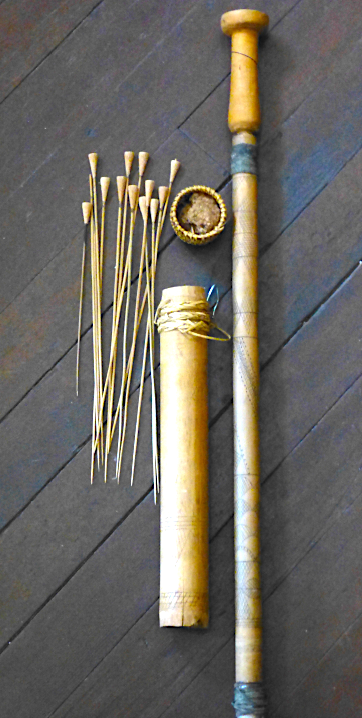Sumpitan (Sakai Blowpipes)
These two blowpipes, one with its full quiver of darts and one without, are typical of those produced by the Sakai of the Cameron Highlands in Kalenten and Perak, Malaysia. Sakai blowpipes consist of an inner and a protective outer tube; these are both the decorated inner tubes, incised with geometrical designs that are then filled with ink in a process very similar to scrimshaw.
The blowpipes are made from lengths of bamboo, both around six feet long, the nodes of which are pierced to produce the long tubes required for the weapon, which are meticulously smoothed using lengths of roughened rattan drawn back and forth within the pipe. The finished blowpipe's inner tube is furnished with a mouthpiece carved of wood with a hole bored in it; the trumpet shaped piece is fixed with narrow band of waxed rattan, while the opposite end is covered with cane kept in place with dried resin. The first pipe is accompanied by a bamboo quiver of fine darts, which would have been tipped with poison for hunting. Each dart consists of a long sliver cut from the midrib of a palm leaf, and the butts of the are sized to match the circumference of the inner tube in order to render the airtight seal necessary to produce the tremendous power and accuracy of the Sakai blowpipes.
Though the blowpipe is widespread throughout Malaysia and island Southeast Asia, the Sakai version was believed by early anthropologists and collectors to be the most powerful and accurate, some even possessing rifled inner tubes. Today, blowpipes are more often used for sport than for hunting, and a skilled sumpitan user (male or female) can accurately hit a target a couple of inches across at a distance of 20-30 meters (65-100 feet). This requires terrific strength of abdomen and forearms, as the relatively heavy pipes are held in both hands only at the base and the dart is propelled by force of breath alone; sumpitan shooters often experience considerable pain in their wrists as well as in their midriffs and cheeks due to the constant forceful blowing.
Although blowpipe darts are much lighter than arrows and pack less energy, they are extremely fast and accurate. Blowgun darts can travel at speeds of over 400 feet per second; this is roughly twice the velocity of an arrow from a conventional wooden bow. Blowpipes are therefore ideal for hunting small game at short range. They are also surprisingly silent, often allowing a hunter to get off a second shot if the first missed. The relatively easy to make darts allow a hunter to shoot birds and monkeys in trees, or larger game like wild pigs in the thick underbrush. Shooting into a tree using a bow can be expensive, since a miss can cause the loss of an arrow or at least require a difficult and dangerous recovery. In densely forested parts of Southeast Asia blowguns actually completely replaced bows over time. They were, contrary to conventional wisdom, rarely used on humans - the hand held common variety of blowgun was rarely used in warfare.
Dart quiver: bamboo, woven rattan, 30.5 x 4cm; darts: sharpened palm and pith, 15.5 x 1cm
Pipe: bamboo, carved wood, waxed plant fiber, 179 x 4cm;
Nelson South East Asia Collection © 2025

